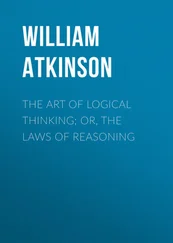VII. Avoid the tendency and temptation to inject Argumentative Proof into your Statement. Reserve your artillery fire until the psychological moment. The statement is merely the “promise of proofs to come.”
Lord Abinger, an eminent advocate, said: “I found from experience, as well as theory: that the most essential part of speaking is to make yourself understood. For this purpose it is absolutely necessary that the Court and jury should know as early as possible de qua re agitur . It was my habit, therefore, to state in the simplest form that the truth and the case would admit the proposition of which I maintained the affirmative and the defendant’s counsel the negative.”
Chapter XI.
Argumentation
Table of Content
THE FOURTH step in an Argument is that of Reasoning , which is the great step or phase, and to or from which all else leads or follows. Reasoning is the essence of the Argument. This step of the Argument may be divided into two stages, i. e., (1) The Proposition or statement of that which is to be proved or disproved; and (2) The Proof or Discourse in which is embodied all that tends to prove or disprove the Proposition.
The purpose of the Argument is to convince and persuade the hearers that the proof adduced is sufficient to sustain or refute the proposition. The Proposition is usually introduced in the Statement. It is of the utmost importance that one should thoroughly understand and explain to his hearers the exact thing that he undertakes to prove or disprove. The issue should be made perfectly plain and clear. As Hill well says: “Nothing can free a writer or a speaker from the obligation of having the proposition distinctly fixed in his own mind before he begins his argument; for he cannot safely take the first step toward proving a proposition until he knows exactly what proposition is to be proved. The process of investigation, by which a man arrives at certain conclusions, should be completed before the argumentative process, by which he endeavors to convince others of the correctness of those conclusions, can advantageously be begun.” We have seen, in the consideration of the Statement, the necessity of making clear to one’s hearers the real point or points at issue. The issue, or true point of dispute and argument, should be discovered and clearly stated before the argument proceeds to the stage of proof or disproof.
Hyslop says of Probation or Proof: “Probation is the process of proof, the statement and arrangement of facts and truths which will establish belief or knowledge in regard to the proposition at issue, or the contrary. The thesis or issue is the proposition to be proved or disproved. The truths which prove or disprove it are the known facts and principles which may constitute the premises, and the thesis will be the conclusion. These determining truths may be axioms, postulates, proved propositions, or any truth or fact which the person to whom the probation is presented may accept. Their acceptance is the condition of their proving or disproving anything. We must observe, therefore, that probation, as here discussed, is a material as well as a formal process. The object in proof is not merely to have correct reasoning, but also to have correct and true propositions. We must, therefore, enunciate some facts or principles accepted by the person to whom the probation is presented, and then bring the thesis or issue under it in such a way as to enforce conviction, or at least make it the most probable alternative. * * * Whenever any proposition is asserted or made the subject of argument, the object is to show whether it be true or false. The general method of argumentation is the same for both sides. But the proposition at the outset is supposed not to represent any conviction in favor of or against itself , but to be balanced between belief and disbelief, or certitude and denial. The problem is to influence the judgment so that it will decide in favor of or against the proposition. Proof or confirmation is the process of determining the conviction one way or the other, and of removing the balance or doubt so that some degree of assent or denial, whether of belief or knowledge, will follow as a consequence.”
The authorities first divide Proof into two general classes; viz., (1) Direct Proof, or the process of sustaining a given proposition; and (2) Indirect Proof, or the process of refuting objections to a given proposition. Of course, the refuting of an objection to a given proposition does not directly prove the proposition itself, but it removes from the argument an obstacle to direct proof and is therefore of value, indirectly.
Another division of Proof is that of: (1) Proof by Deductive Argumentation; and (2) Proof by Inductive Argumentation. Proof by Deductive Argumentation is that in which Deductive Reasoning is employed—where the process of reasoning seeks to derive a particular truth from a general truth. Thus, from the general truth that “All men are mortal,” and the fact that
“Socrates is a man ,” we may prove by Deductive Argumentation that “Socrates is mortal.” Proof by Inductive Argumentation is that in which Inductive Reasoning is employed—where the process of reasoning seeks to derive a general truth from particular truths. Thus, from the particular truths that “Heat will expand iron, zinc, copper, gold, silver, etc.” we may prove by Inductive Argumentation that “Heat will expand all metals.”
Of course, all general truths must have been originally reasoned by induction from particular truths, and being so established have become bases for deductive reasoning from which particular truths may be established. There are certain general truths or principles which are generally accepted as axiomic or “self-evident truth,” without the necessity of argument. In Deductive Argumentation, the argument proceeds from an accepted general truth and attempts to establish the fact that a particular proposition comes under, or is included in, that general truth, and is thus a particular truth. In Inductive Argumentation, the argument proceeds to show the apparent existence of a general truth in a number of particular things, from which it may be supposed or reasonably believed that the general law exists as a truth. The rule in Inductive Reasoning is that: “The probability of a hypothesis is in proportion to the number of facts and phenomena it will explain.”
Arguments may be classified, according to form, as follows: (1) Argument based upon Cause and Effect; (2) Argument based upon Analogy; (3) Argument based upon Association.
Argument based upon Cause and Effect is sometimes known as “Argument from Antecedent Probability.” It is based upon the general principle or axiom that: “From the same causes, under the same circumstances, the same results will flow.” This axiom is based upon man’s belief in the uniformity of natural laws. From this, we arrive at the belief that given a certain cause, under certain circumstances, we may safely infer the presence of a certain effect; or given a certain effect, under certain circumstances, we may safely infer the presence of a certain cause. In order to reason or argue along these lines, however, we must understand that there are certain “Tests of Casual Agency” accepted by logicians, by which we may ascertain the casual agency in any particular case, and thus make an inductive inference. These “tests” are as follows:
I. The Method of Agreement : “If, whenever a given object or agency is present, without counteracting forces, a given effect is produced, there is strong evidence that the object or agency is the cause of the effect.”
II. The Method of Difference : “If, when the supposed cause is present the effect is present, and when the supposed cause is absent the effect is wanting, there being in neither case any other agents present to effect the result, we may reasonably infer that the supposed cause is the real one.”
Читать дальше












